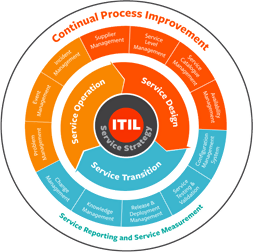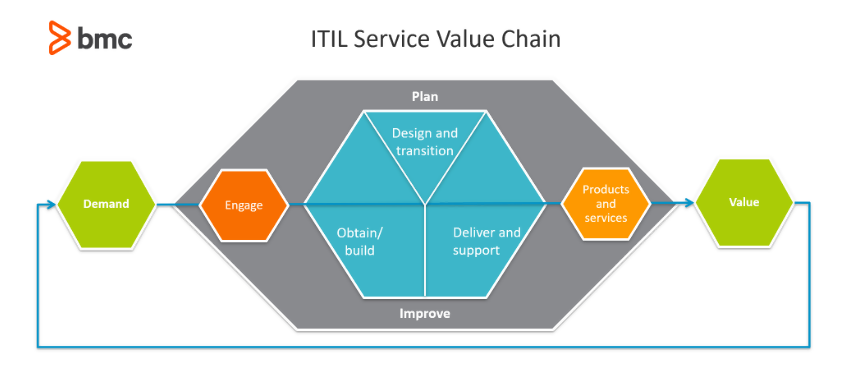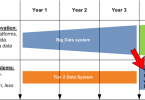ITIL service delivery occurs when an organization performs an IT service for a customer that meets two criteria: First, it should produce an outcome that the customer values. Secondly, the customer shouldn’t have to manage the outcome’s costs and risks. Services are designed, deployed, delivered, improved, and retired by using the ITIL framework.
You might not know how to answer if I asked you “What is ITIL inside an IT Service Management (ITSM) environment?” ITIL service delivery in ITSM sounds like an abstract technical concept, but it’s at the core of what we do as IT professionals.
Download Now: ITIL 4 Best Practice e-Books
These all-new for 2020 ITIL e-books highlight important elements of ITIL 4 best practices. Quickly understand key changes and actionable concepts, written by ITIL 4 contributors.
Let’s demystify the concept of ITIL service delivery and build an unofficial, working definition. I’ll do this by:
- Looking at ITSM and ITIL
- Defining an IT service
- Explaining types of IT services
- Exploring the evolution of ITIL service delivery
By the end of this post, you’ll understand ITIL service delivery and how it affects your organization. Most importantly, you’ll be able to answer the question: What is ITIL service delivery? (For the quick answer, skip to the bottom of this post.)
What are ITSM and ITIL?
ITSM refers to all activities, plans, and processes an organization uses to design, deliver, and manage service delivery for its customers. The Information Technology Infrastructure Library (ITIL®) is a set of best practices and a universal framework for implementing ITSM. Together, ITSM and ITIL enable IT service delivery for almost any business.
Customers can request services through an IT service catalog, where IT publishes the services it offers. When you deliver an IT service through a service catalog request, you are engaging in ITIL service delivery.
What’s an IT Service?
The ITIL v4 framework defines a service as “…any means of enabling value co-creation by facilitating outcomes that the customer wants to achieve, without the customer having to manage specific costs and risks.”
There are three assumptions implicit in this service definition.
- IT organizations provide IT services that produce outcomes (value) that the customer desires
- Service delivery produces positive results (value co-creation) for the customer
- An IT organization manages the costs and risks associated with service delivery
As Joseph Mathenge wrote in his excellent post on Defining What is an “IT Service”, value is co-created between the customer and the IT provider. The customer defines service requirements and gains benefits (value) from using the service. IT creates and delivers the technical components needed for the service (such as coding, data mining, security, and reporting), shouldering the expenses, delivery, and maintenance costs and risks of the service.
With this understanding, an unofficial starting definition of ITIL service delivery is: ITIL service delivery occurs when an IT organization performs an IT service that the customer values and desires and that the customer cannot or does not want to perform themselves.
What types of IT services are there?
An IT service is customer centric, as it aligns with the customer’s processes and lives in their environment.
Today most IT services are delivered digitally. The customer requests or consumes the service through the device of choice, whether a website, mobile interface, kiosk, smart speaker, IOT device, or any other interface. Video delivery services must be delivered to a video-enabled device, for example. Customer accounts must be verifiable through any device the customer uses.
Generally, an IT service creates, modifies, manages, or provides access to these general IT service categories.
- Business process service for performing repeatable activities that achieve a concrete goal for the customer. IT business process services usually follow a process that has specific starting and ending points, such as entering orders, running on-demand processes, or updating employee information.
- Application services, including installing, configuring, and providing access to all offered applications.
- IT skill services that use internal or external IT resources to design, build, or run a service for the customer, including programming, troubleshooting, installing, and operating the service.
- Software and hardware services, including requesting new software and equipment (such as smart phones, computers, or IOT devices) as well as break fix and replacement services for existing equipment
- Infrastructure services, such as building, maintaining, and configuring network infrastructure components (app servers, web servers, telecommunication lines, firewalls, etc.) needed for accessing applications or other services.
IT services can be provided by an organization’s internal IT department or outsourced to an external vendor.
A single IT service can encompass several related services. For example, you may add an IT service called ‘add a new network user’. When a user requests this service, it spawns additional sub-services including creating a network profile, creating an email account and ERP system access, configuring a Windows desktop, or authorizing printers or mobile devices. Each sub-service may be satisfied by a different group, but they are ordered and delivered as a single service.
Given these requirements, we can modify our working definition of ITIL service delivery changes to: ITIL service delivery occurs when an IT organization performs an IT service (business process, application, IT skills, hardware, software, or infrastructure service) that the customer values and desires and that the customer cannot or does not want to perform itself.
The evolution of IT service delivery
ITIL service delivery is achieved differently across the ITIL v2, v3, and v4 standards.
In ITIL v2, ITSM was separated into two core disciplines:
- Service support, including incident, change, release, and configuration, and service desk management)
- Service delivery, including service level, capacity, availability, and financial management, along with contingency planning).
IT services were created and delivered in accordance with this ITIL v2 framework, which is still used minimally, but it has been largely bypassed in favor of the newer ITIL v3.
In ITIL v3, service delivery evolved with the introduction of the IT service lifecycle that focused on the five core areas, shown in Figure 1:
- Service strategy
- Service design
- Service transition
- Service operation
- Continual service improvement

Figure 1: The ITIL v3 services lifecycle
In ITIL v3, service support and service delivery were no longer separate disciplines. ITIL v3 service delivery provided a birth-through-retirement template for the lifecycle of each service. ITIL v3 is the more established framework that is widely used today, at least until the IT world moves to ITIL v4, which was introduced in spring 2019.
In ITIL v4, the service value chain (SVC) supplants the service lifecycle from ITIL v3. The SVC is the delivery component of the service value system (SVS), and it is implemented with other SVS components. Like the ITIL v3 service lifecycle before it, the SVC is an operating model for the creation, delivery, and continuous improvement of IT services. But instead of the five core areas defined for ITIL v3, the SVC focuses instead on these six core areas:
- Plan
- Engage
- Design and transition
- Obtain/build
- Deliver and support
- Improve

Figure 2: The ITIL v4 Service Value Chain (SVC)
The SVC relies on demand (inputs) such as policies, requirements, opportunities, or product and knowledge changes. The SVC evaluates and processes its inputs until it delivers an output in the form of a service outcome that delivers value to the customer.
ITIL v4 moves away from delivering IT services to internal users to enabling and co-creating value with customers and non-IT parts of the business. Where ITIL v3 focused more on how to deliver services, ITIL v4 focuses more on how to co-create value with the customer for the services you’re delivering. ITIL v4 also focuses more on digital transformation than straight IT delivery and provides guidance on newer development techniques for delivering IT services, such as Agile, DevOps, and lean. As such a recent version, ITIL v4 is not nearly as widely used as its predecessor—yet.
The final definition of ITIL service delivery
Given our starting definition of ITIL service delivery, the types of services that are offered, and the continued evolution of ITIL service delivery, our final unofficial definition of ITIL service delivery changes to the following:
ITIL service delivery occurs when an IT organization performs an IT service (business process, application, IT skills, hardware, software, or infrastructure service) that the customer values and desires and that the customer cannot or does not want to perform itself. Services are designed, deployed, delivered, improved, and retired following either the ITIL v3 service lifecycle or the ITIL v4 service value chain.
And that’s how you can answer the question: What is ITIL service delivery? To learn more about ITSM, the ITIL framework, and ITIL service delivery, check out The BMC Complete Guide to ITIL.
Additional Resources








